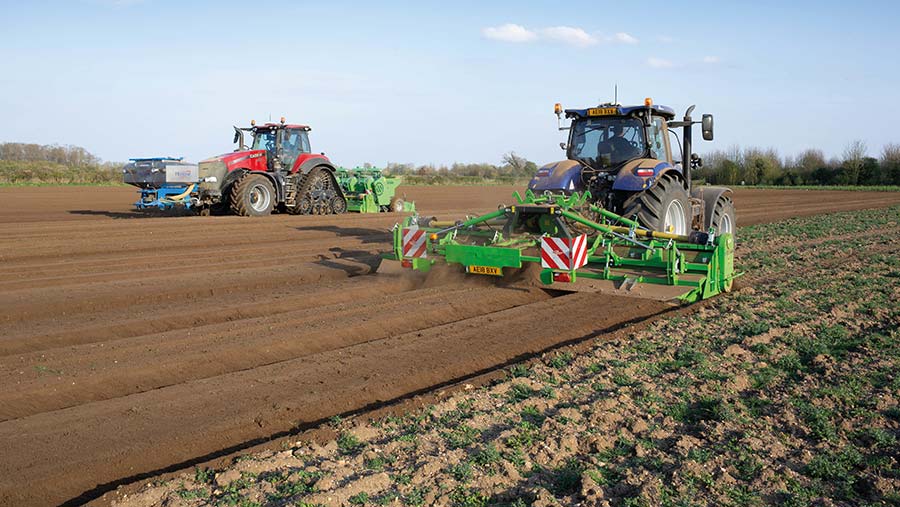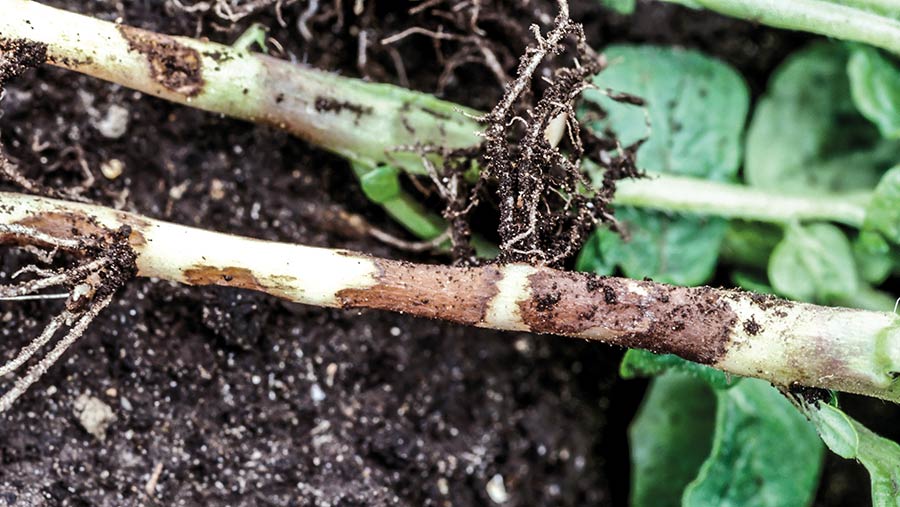What potato seed treatment changes mean for application
 © Tim Scrivener
© Tim Scrivener A further narrowing of the potato seed treatment options and application methods available to growers is putting a focus on liquid products where seed-borne rhizoctonia control is required.
While there are still both powder and liquid treatments on the market, changes to the line-up are ongoing, with another powder treatment disappearing this year.
See also: How breeding can help farmers manage PCN in potatoes
As the options reduce further, growers will have to decide whether to have seed treated at source or on the farm, either by themselves or by contractors.
Product updates
To re-cap, the abrupt withdrawal of Monceren (pencycuron) last year saw the end of manual application of powder treatments, as it was the only product permitted to be hand sprinkled on tubers.
This year will be the last for another powder product from Bayer, Emesto Prime (penflufen), following confirmation that final use will be by the end of June 2021.
An unchanged maximum residue limit means that any crops treated this year will remain marketable.
With its wider activity against seed-borne diseases, Emesto Prime had a place on potatoes destined for markets where better skin finish characteristics are important.
Applied with an on-planter applicator, it was reported to stick well and be retained on the tubers.
Its imminent departure means that after this season, the only powder on the market will be Rhino DS (flutolanil) from Certis, which is also applied on the planter with a specialist applicator to ensure good seed coverage.
Recognised for controlling more strains of rhizoctonia than Monceren did, Rhino DS costs around £15-18/t.
For those who don’t want to change their application practice and move to liquids, it is fast becoming their only option.
Liquid treatments
Where liquids are preferred for their better coverage, safety credentials and handling characteristics, the choice is between Rhino Flow and Maxim 100 FS (fludioxinil).
These differ in price and disease control spectrum, with Maxim from Frontier Agriculture being both a contractor applied material and available for treatment at source or on-farm.
Its higher price tag of around £25/t reflects its wider disease activity, which includes silver scurf and black dot along with rhizoctonia, while there is also a contractor application fee of around £10/t for those who choose that option.
Deciding whether to have seed pre-treated, applied by professional contractors or to make applications on-farm will depend on the individual farm circumstances and previous practice.
Hutchinsons agronomist Andrew Goodinson, also points out that seed should be examined for disease when it arrives.
“Wash the sample off and do a visual assessment. You can also send samples off to NIAB for testing to see if treatment is needed.”
Where it is required, he notes that all of the choices have good efficacy on black scurf but has a preference for liquid products, believing it is often better to treat potatoes before they go out to the field.
Planting pressures
“The planter operator is already very busy and there have been issues in the past with contamination and poorer coverage with powders. Treating seed on the planter is not always straightforward.”
He also stresses that all the seed treatments are ineffective against soil-borne rhizoctonia, which is where in-furrow applications of products such as Amistar (azoxystrobin) and Allstar (fluxapyroxad) have a place.
Nick Badger of Frontier Agriculture agrees that complexities at planting have seen a drive to get the treatment of seed done earlier, with growers moving away from powders and into liquids, being keen to get seed onto farm and manage their own stocks.
“With liquids, there are three main application options,” he confirms. “Seed can be treated at source, before it is dispatched, if the seed house offers that service.”
Alternatively, a professional contracting service can call at the farm to carry out the operation, with Frontier having a mobile application service operating in most parts of the country.
The third option is that the farm carries out its own treatment over the roller table, using a specialist applicator.
While this may require investment, installation of bespoke equipment often coincides with an overhaul and re-design of the grading line.
“The loss of two powder products is concentrating minds and growers are looking at what’s needed for using liquids.”
Taking equipment off the planter is beneficial for many reasons, he notes, while the application characteristics of liquids are better for both operators and crop performance.
“There’s been a lot of change, but there’s also been greater sophistication introduced, which is no bad thing.”
Powders at planting
- RhiNo DS (flutolanil)
- Emesto Prime (penflufen)*
Liquids at grading
- Maxim 100 FS (fludioxinil)
- RhiNo Flow (flutolanil)
* Final sales and use of Emesto Prime must be done by 30 June 2021
Rhizoctonia solani

© Blackthorne Arable
Rhizoctonia solani is a fungal disease causing stem canker, damping off, black scurf, skin netting and tuber growth distortions in potato crops. Black scurf can be soil and seed borne and survives a long time in soil and on volunteers or crop debris.
Symptoms
Affected roots, stems and stolons show reddish brown necrotic patches called cankers.
A stem canker can cause symptoms similar to those of blackleg, in that plants are stunted and develop a rolling of the upper leaves.
Brown, slightly sunken lesions with distinct edges develop on the stem base and on stolons.
If severe, lesions can merge to girdle the stem. Later a white collar can develop on the stems at soil level. The resulting pruning of the stem can lead to uneven emergence and gaps in crops.
On the tuber, black scurf is an entirely superficial black incrustation (sclerotia). It usually appears as small, irregular blemishes that can be extensive, but easily scratched off.
Affected tubers can show growth distortions that resemble glyphosate damage. Affected areas usually show retarded growth in association with thickened brown skin patches that are often referred to as netting or elephant hide.
Other distortions include dimples and trumpet shaped holes penetrating the tuber.
Source: AHDB

